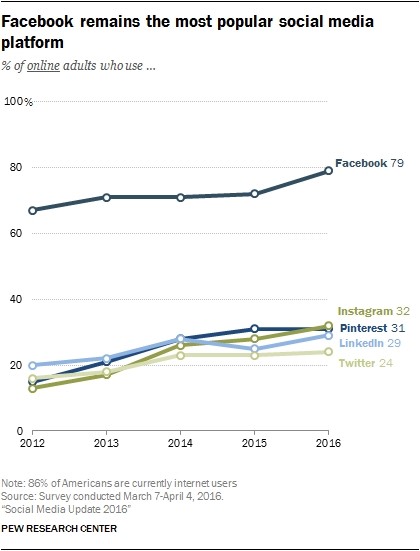
So you started a new business. Congratulations!
Now comes the hard work: marketing and promotion.
You know you need to be on social media, but you have no idea where to start. With so many platforms, and so little time, what’s an entrepreneur to do?
First of all, everyone is on Facebook, so you definitely need to have a presence there. But have you forgotten about Twitter, Snapchat, LinkedIn, Pinterest, Instagram, Tumblr, Google+, Reddit? And those are just the first platforms that come to mind…

Don’t worry, though. I got you covered!
The following seven considerations will help you determine which social media channels you should focus on.
1. Your Customers
A smart part of any marketing strategy is developing buyer personas. These will be used to inform all of your marketing efforts, including social media.
Imagine your ideal customers. What are their basic demographics (age, gender, salary, location)? Now all you have to do is find social networks that match those demographics.
Some networks have distinct gender preferences. For example, women strongly favor Instagram, Facebook, and Pinterest, but there are twice as many men on Reddit.
As for age, seniors (people 70 and older) are the fastest-growing demographic on social media, and there are even dedicated networks for them, including Stitch for those aged 50 and above. Seniors show a strong preference for YouTube, too, with over half of Baby Boomers and seniors watching online videos.
On the other end of the spectrum, Snapchat, Instagram, and Reddit all have much younger viewers: 90% of Instagrammers and 86% of Snapchatters are under age 35, and 64% of Redditors are under age 30.
So, do your research and see which one is best for your target audience!
2. Your Industry
Depending on the industry, certain social media platforms are better to use than others. That’s not to say your Social Media Management brand can’t break through as the next big Instagram star, but leaning into the networks where your industry already does well makes things easier when you’re first starting out.
For example, if you’re in the fashion industry, you’d want to focus on Pinterest and Instagram rather than LinkedIn. But if you’re in the tech B2B vertical, LinkedIn would be the right choice. All local businesses of any industry need to fully complete their
Google+ profiles and encourage regular Google+ reviews for SEO purposes.
What about B2B versus B2C? According to a 2016 industry report by Social Media Examiner, B2B marketers heavily favor LinkedIn and SlideShare. B2C marketers, on the other hand, prefer Facebook, Instagram, and Pinterest.

3. Your Company
What is it that makes your brand unique? You may be able to use that differentiation in the social network of your choice.
For instance, Marcus Sheridan became famous in the world of marketing for using content to build his pool company into a huge success. If you have a big personality, consider streaming live via Facebook Live or Snapchat.
Do you regularly attend tradeshows? Twitter and Instagram are huge hashtag hubs during such events, which can help your content get discovered.
Just find your “thing.” You might post photos on Instagram of quirky places where people can use your product, or you can create a weekly video series where you share tips based on the service you offer.
4. Your Competition
No matter how unique your business is, you’ll always have competition. Lucky for you, having competition isn’t all that bad.
If you pay attention to what the competition is doing, you’ll gain insights into what works and what doesn’t. Have you ever seen something flop… and then decided you could make it better? That may have been what motivated you to start your business in the first place!
For your social media strategy, look at your competition’s social accounts. Focus only on the companies doing well and those that you aspire to be like one day. The ones that aren’t successful aren’t worth copying and could even lead you in the wrong direction (they’ll be the ones over-indexing on Reddit and Snapchat even though they work exclusively with adults age 45+).
Take note of which platforms your competitors use and what kind of content tends to encourage engagement for them. Consider how you can apply that information to your brand.
5. Your Product or Service
Certain products and services perform better than others on various social media channels.
Do you run an e-commerce site? Pinterest users spend 50% more than those on
other social networks and are likelier to click through to your website to purchase.
Work in the beauty industry or spend a lot of face time with your customers?
Instagram pictures showing faces get 38% more likes than those without.
Cars and apparel enjoy an outsized presence on Instagram, whereas consumer products don’t do well on LinkedIn.
6. Your Goals
What are your primary goals for social media? Do you want to nurture leads, grow your referral traffic, foster customer loyalty, build brand awareness, or achieve something else entirely?
Buffer offers the following list of smart social media goals:

Certain social channels will serve your goals better than others. For example, Instagram doesn’t allow links in posts (unless you’re a paid advertiser), so the platform is better suited to brand awareness and customer loyalty. You’ll certainly gain visibility through hashtagging your posts, and you’ll foster customer happiness by sharing exclusive promo codes, but you won’t drive traffic to and conversions on your website.
Focusing on SEO? Use YouTube. Videos hosted there are more likely to show up in Google’s search results. You can also upload transcripts and include annotations to make them even more searchable and to drive site traffic.
Whichever goal you choose, ensure you can measure your progress, whether that’s by number of leads, traffic volume, or number of likes or other engagement action.
7. Your Content
Finally, what kind of content will you be sharing on social media?
If your business is highly visual and you plan to produce lots of video or image content, focus on Instagram, Facebook, and YouTube, or possibly Snapchat, depending on the ages of your target audience (see consideration No. 1). Facebook Live is a particularly nice option if live content makes sense for your business.
If you’ll be creating lots of written content, including blog posts, case studies, and whitepapers, make sure to share them on Twitter, Facebook, and LinkedIn.
If you don’t have time to blog yet, you can still find a voice by curating others’ content and retweeting on Twitter. You can also comment in discussion boards, including Reddit and LinkedIn Groups.
Will you be creating brand experiences or fun content for brand awareness?
Instagram and Snapchat are perfect for that purpose. And don’t forget to promote any upcoming events on Facebook!
Bonus Tip
Regardless of which platforms you choose to focus on right now, at a minimum you should create a profile for your company on all the major social networks. As your business and your team grow, you’ll have more time to dedicate to different platforms.
Plus, it’s just plain smart to own your brand name online. Signing up on all the major platforms prevents a troll from registering your brand name, forcing you to do business under @company_name1 instead of the objectively more professional @companyname.
You’ll also get a chance to include a backlink to your website in your profile for many of these sites, so you’ll get an SEO benefit out of it. Too busy? Services like KnowEm will do the work for you.
As your business grows, you’ll expand into other platforms and your social media marketing will expand as well. You’ll use different channels for different goals and craft content for specific networks.
Until then, focus on one or two networks to really grow your awareness, hone your strategy, and build your fan base. The seven considerations outlined in this article will show you the way!





equilibrado de ejes
Sistemas de calibración: fundamental para el funcionamiento suave y productivo de las equipos.
En el entorno de la ciencia actual, donde la productividad y la confiabilidad del sistema son de máxima importancia, los equipos de calibración tienen un rol vital. Estos dispositivos especializados están desarrollados para equilibrar y asegurar componentes rotativas, ya sea en equipamiento industrial, transportes de transporte o incluso en dispositivos domésticos.
Para los especialistas en mantenimiento de aparatos y los especialistas, manejar con sistemas de equilibrado es crucial para garantizar el desempeño suave y fiable de cualquier dispositivo rotativo. Gracias a estas soluciones avanzadas sofisticadas, es posible disminuir sustancialmente las oscilaciones, el sonido y la presión sobre los cojinetes, aumentando la duración de partes caros.
También importante es el función que cumplen los dispositivos de balanceo en la soporte al consumidor. El apoyo técnico y el mantenimiento constante aplicando estos dispositivos posibilitan brindar soluciones de gran nivel, aumentando la agrado de los clientes.
Para los responsables de proyectos, la inversión en sistemas de ajuste y detectores puede ser fundamental para aumentar la eficiencia y rendimiento de sus equipos. Esto es principalmente importante para los emprendedores que gestionan medianas y pequeñas organizaciones, donde cada elemento importa.
Además, los dispositivos de ajuste tienen una gran aplicación en el área de la seguridad y el control de estándar. Facilitan identificar potenciales errores, impidiendo mantenimientos elevadas y perjuicios a los sistemas. También, los indicadores recopilados de estos equipos pueden emplearse para maximizar sistemas y aumentar la reconocimiento en sistemas de búsqueda.
Las campos de aplicación de los dispositivos de equilibrado incluyen diversas áreas, desde la elaboración de transporte personal hasta el seguimiento ambiental. No interesa si se considera de grandes fabricaciones industriales o pequeños locales caseros, los sistemas de equilibrado son esenciales para garantizar un desempeño óptimo y sin presencia de interrupciones.